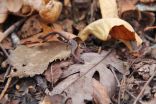(Press-News.org) EUGENE, Ore. -- Nov. 18, 2014 -- Leave it to long-dead short-tailed shrew and flying squirrels to outfox climate-modelers trying to predict future habitats.
Evidence from the fossil record shows that gluttonous insect-eating shrew didn't live where a species distribution technique drawn by biologists put it 20,000 years ago to survive the reach of glaciers, says University of Oregon geologist Edward B. Davis. The shrew is not alone.
According to a new study by Davis and colleagues, fossil records of five ancient mammalian species that survived North America's last glacial period point to weaknesses in the use of ecological niche models and hindcasting to predict future animal and plant habitats. As a result, Davis says, the modeling needs to be fine-tuned for complexities that might be harvested from fossils.
Ecological niches use modern habitat distributions and climate; hindcasting adds predictive power by adding major past climate shifts into the models. That modeling combination -- as seen in a 2007 study led by Eric Waltari, then of the American Museum of Natural History in New York -- had the short-tailed shrew surviving the last ice age in mostly Texas and the Deep South. Conclusions drawn in other studies, Davis noted in the new study, also are biased toward southern locations for ice-age surviving mammals of the Pleistocene Epoch.
Short-tailed shrew, according to fossil records, did not live in the predicted ranges. Instead they lived across north central and northeast United States, closer to the glaciers and where they are widely found today.
"It's almost as though it is living in all of the places that the model says it shouldn't be living in and not in any of the places that the model says it should be living in," said Davis, who also is manager of the paleontological collection at the UO Museum of Natural and Cultural History. "This suggests to me that whatever the model is keying on is not actually important to the shrew."
Nor to the American marten, two species of flying squirrels and the Gapper's red-backed vole, all of which lived mostly outside of predicted ranges, according to the fossil record. Northern and southern flying squirrels, the Davis study found, shared a compressed geographic region. It may be, Davis said, that some species tolerate competition under harsh conditions but separate when abundant resources are available.
Davis noted that an important but under-cited 2010 paper on rodents by Robert Guralnick of the University of Colorado and Peter B. Pearman of the Swiss Federal Research Institute also showed problems with hindcast projections. Those for lowland rodents in the last ice age did not hold up, but those for a higher elevation species did.
"Our findings say that we need to pay more attention to the potential problems we have with some of our modern methods, and the way that we can improve our understanding of how species interact with the environment," said Davis, who added that his study was inspired by Waltari's. "The way to improve our forecasting is to include data from the fossil record. It can give us more information about the environments that species have lived in and could live in."
The findings appear in the November issue of the journal Ecography. In a special section of the journal, the Davis paper is packaged with four papers on research initially presented in a symposium on conservation paleobiogeography in 2013 at a biennial meeting of the International Biography Society. The Davis paper is co-authored by Jenny L. McGuire, now at Georgia Tech University, and former UO doctoral student John D. Orcutt, who is now at Cornell College in Iowa.
Davis and McGuire co-hosted the symposium, edited the special issue and penned an editorial that accompanies the five papers. Conservation paleobiogeography, Davis said, "is the idea that we can help people understand questions that arise from conservation needs using data from the fossil record." Doing so, he said, may explain how species shift their ecological roles, or evolve, to survive amid abrupt changes in their habitats.
"Our paper raises questions about some of the work on projecting future ranges of mammals, and we suggest some directions forward," Davis said. "We have concerns about the precision of the modeling techniques now being used. We don't have any concerns about climate change happening and that it going to cause geographic range shifts for mammals and plants. The thing I want to do, as a scientist, is to have the best models possible so as we're making informed decisions as a society."
INFORMATION:
The National Science Foundation (grant EF-0905606) partially funded McGuire's work on the project while she was on a fellowship at the National Evolutionary Synthesis Center, which is jointly operated by Duke University, the University of North Carolina at Chapel Hill and North Carolina State University.
Source: Edward Davis, assistant professor of geological sciences, 541-346-3461, edavis@uoregon.edu
Note: The University of Oregon is equipped with an on-campus television studio with a point-of-origin Vyvx connection, which provides broadcast-quality video to networks worldwide via fiber optic network. In addition, there is video access to satellite uplink, and audio access to an ISDN codec for broadcast-quality radio interviews.
Links:
Davis faculty page: http://geology.uoregon.edu/profile/edavis/
UO Department of Geological Sciences: http://geology.uoregon.edu/
Museum of Natural and Cultural History: http://natural-history.uoregon.edu/
Davis paper abstract: http://onlinelibrary.wiley.com/doi/10.1111/ecog.01294/abstract
McGuire-Davis editorial: http://onlinelibrary.wiley.com/doi/10.1111/ecog.01337/full
Hamilton, ON (Nov. 18, 2014) - McMaster University researchers have found new evidence that suggests patients with a history of adverse reaction to the blood thinner heparin may be ready for urgent heart surgery sooner with a combination of appropriate blood screenings and therapeutic plasma exchange.
The study was published online today in Blood, the journal of the American Society of Hematology. The lead author is Dr. Theodore Warkentin, a professor in the Department of Medicine's Division of Hematology and Thromboembolism and the Department of Pathology and Molecular ...
The consumption of a diet high in fructose throughout adolescence can worsen depressive- and anxiety-like behavior and alter how the brain responds to stress, according to new animal research scheduled for presentation at Neuroscience 2014, the annual meeting of the Society for Neuroscience and the world's largest source of emerging news about brain science and health.
"Our results offer new insights into the ways in which diet can alter brain health and may lead to important implications for adolescent nutrition and development," said lead author Constance Harrell of ...
Washington, D.C. - November 18, 2014 - Lumosity is presenting new research today at the 2014 Society for Neuroscience conference on how altering cognitive task parameters affects learning rates. The study, titled "Optimizing Cognitive Task Designs to Improve Learning Rates in a Large Online Population," analyzed game play performance from 99,022 participants, and found that participants operating closer to their performance threshold earlier in their experience with a cognitive task tend to have faster learning rates - especially at higher levels of difficulty.
"By looking ...
Ticagrelor halves risks of stents blocking with blood clots
Study of 18,000 patients shows cost-effective drug could prevent premature deaths
Reduces the risk of patients needing repeat operations
Treating heart attack patients with ticagrelor reduces the risk of stents blocking with blood clots according to a ground breaking new study conducted by researchers from the University of Sheffield.
The new findings confirm that treating heart attack patients with the pioneering drug ticagrelor, instead of the previous standard treatment clopidogrel, could halve the risks ...
COLUMBIA, Mo. - In the 1970s, ecologists published results from one of the first whole-forest ecosystem studies ever conducted in Hubbard Brook, New Hampshire. In the paper, scientists reported that salamanders represent one of the largest sources of biomass, or food, of all vertebrates in the forest landscape. Now, using new sampling and statistical techniques not available during the past study, researchers at the University of Missouri have estimated that the population of salamanders in forested regions of the Missouri Ozarks are 2-4 times higher than originally thought, ...
NEW YORK (November 18, 2014) - The addition of mitral valve (MV) repair (a valve of the heart) to coronary artery bypass grafting (CABG), a type of open-heart surgery, did not result in significant benefit to the patient and was associated with increased risk of neurological events. Therefore, the routine addition of MV repair to CABG in patients with moderate IMR did not demonstrate a clinically meaningful advantage.
The Cardiothoracic Surgical Trials Network (CTSN) is reporting results for the first time from a clinical trial of patients who have a complication of ...
Over the last decade, neuroscientists have largely come to believe that physical pain and social pain are processed by the brain in the same way. But a new study led by the University of Colorado shows that the two kinds of pain actually use distinct neural circuits, a finding that could lead to more targeted treatments and a better understanding of how the two kinds of pain interact.
For the study, published in the journal Nature Communications, the researchers used a technique recently borrowed from the computer science field by neuroscientists--multivariate pattern ...
WASHINGTON D.C., November 18, 2014 - On a quest to design an alternative to the two complex approaches currently used to produce electrons within microwave electron guns, a team of researchers from Euclid TechLabs and Argonne National Laboratory's Center for Nanoscale Materials have demonstrated a plug-and-play solution capable of operating in this high-electric-field environment with a high-quality electron beam.
Unfamiliar with microwave electron guns? Perhaps best known within the realm of X-ray sources, microwave electron guns provide a higher current and much higher ...
Medications, such as chemotherapy, are often limited by their tendency to be detrimental to healthy cells as an unintended side effect. Now research in the November 18th issue of Cell Press's Biophysical Journal offers a new computational model that can help investigators design ways to direct drugs to their specific targets.
A major problem with many cancer drugs is the harmful effects they can have on normal cells. Similarly, treatments for a variety of other diseases can have side effects by acting on cells that are not meant to be targeted. Researchers have tried ...
A mother's "TLC" not only can help soothe pain in infants, but it may also impact early brain development by altering gene activity in a part of the brain involved in emotions, according to new study from NYU Langone Medical Center.
By carefully analyzing what genes were active in infant rat brains when the mother was present or not present, the NYU researchers found that several hundred genes were more, or less, active in rat infants experiencing pain than in those that were not. With their mothers present, however, fewer than 100 genes were similarly expressed.
According ...


